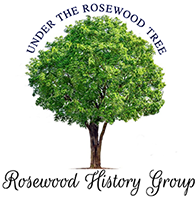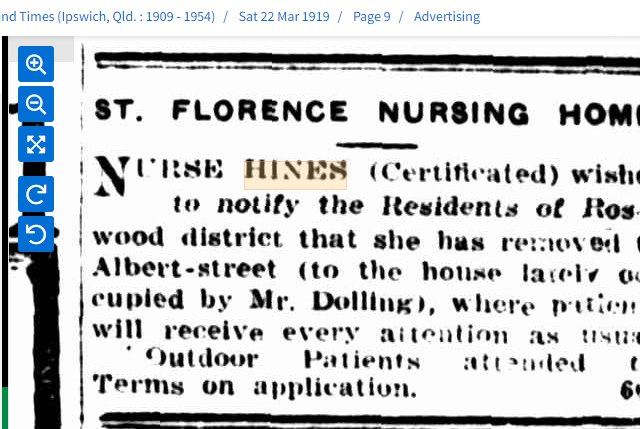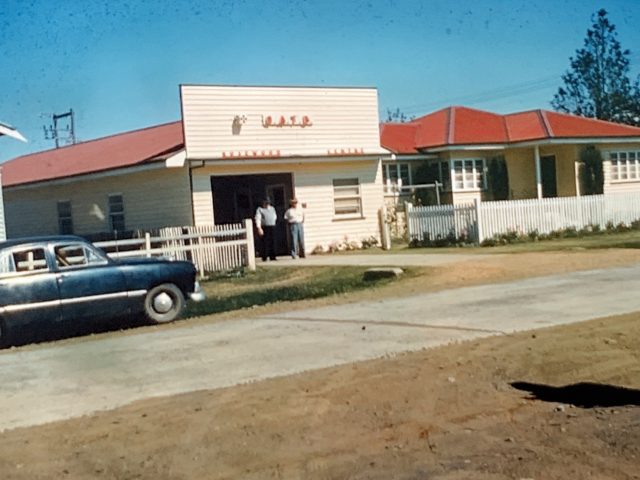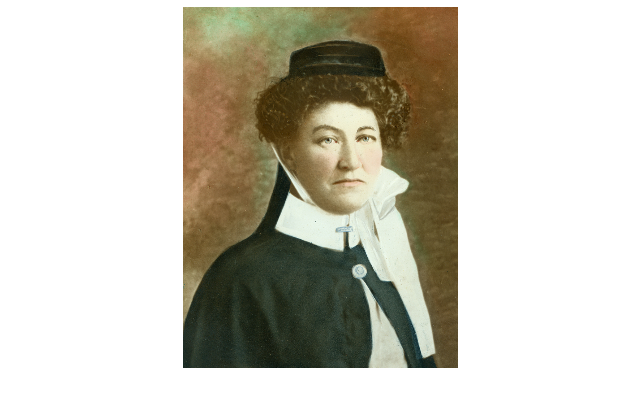John was the first child born to Joseph William Evans and Mary (nee Vance) after they returned to Rosewood.
The story of John and Lilla is told in John’s own words as recorded in his family records.
Two things I remember of the farm before I went to school… a mob of blacks came down the road; it was the only mob that I ever saw, and someone said that they were over 200. They took a long time to pass the house, and we wondered how the oldest sister would get on coming home from school. In my path between the house and kitchen, which were about 8 feet apart, a large carpet snake was stretched. I waited for a drink!
When five years old, I walked to Rosewood School, about 3 miles, and at about that age, I also took flowers to Lilla Dorothy Harding, later my wife. The school had two rooms, the larger had two rows of desks and the smaller one, one row of desks and a gallery, and I often had a sleep at the top of the gallery during school hours. The head teacher was Mr Johns, and one day at the eleven o’clock recess, his two boys wrap me up in his buggy cover and left me there in the play shed when they went back into school. My teacher was Miss Blackmore, and she had me sent for. Coming home from school, we often stopped at Mason’s dam for a drink. The dam was on the east side of John Street about half a mile from the railway and had been built by government. One day, my sister Ann fell in, but another girl caught her dress and pulled her out. When the dam was being made, one man undermined one side, and it collapsed on him, and Harry Beavis had his legs caught but was pulled out. The other man died. We always stopped at the top of John Street to eat the remains of our lunch. One day, one of the big girls saw Mr Johns coming and let out a yell, and we took off in a hurry. After Mr Johns, we had Mr Swan, a good teacher, and the only caning I ever had was from him. After him came Mr Walker; he had been a good teacher, but before eleven, he used to say, “Maggie, your mother wants you.” Maggie said, “I’m not going.” He then went into the other room and said, “Georgie, your mother wants you.” In a few minutes, we would see Georgie (a girl) go into the Rising Sun Hotel with a jug under her arm for a drink for dinner. The beer spoilt him as a teacher, and that year, I went in for scholarship and failed badly. Some time after I started school, father had a two-storey shop and dwelling built in Rosewood, and we shifted in. He rented the farm out. Father was Secretary of the Show Society and kept bees. The next teacher was Mr Tuffley; he was a good teacher and a good musician. One show time was very wet, and the mud came over our boot tops. Mr Tuffley wrote a poem about it and set it to music. The chorus was:
Going to the Rosewood Show, in the rain and mud you know, wasn’t it provoking?
Didn’t we get a soaking? Going to the Rosewood Show?
When I was sixteen, he said that it was time I left; I had been through all the classes, although most of the time at the last, I had been teaching a class of 16.
Father leased the farm to Mr G Harding in 1897. We had cows to milk in Rosewood, and he sold seven of these for 11 pounds to Mr Jas Ponting. When I was fifteen, Uncle J Hucker, his wife was Olivia Vance, sold out what was later Mr G Wright’s property and bought a place at Spring Creek, Clifton, and I helped him drive his cattle up over the Liverpool Range through Laidley, Gatton, and up Ma Ma Creek over the very steep 2-mile length of the Razor Back. Uncle went in front with me behind. We camped overnight, and just after we got up in the morning, when I went for the horses, 2 dingoes were trying to get a calf but soon went. It was a four-day trip up. Next day, I rode 4 miles into Allora to get bread, meat, and groceries. Put them in a sack over the back of the saddle. Uncle had been trying to split off one post all the time I was away. We left about three p.m., camped on Blackfellow Creek, heard dingoes close by and arrived in Lanefield about 3 p.m. the following day.
When I left school, I got a job with G Harding paying five shillings a week. Started very early and sometimes husked corn till 10:00 pm. In December 1899, I won a bursary to Gatton Agricultural College and started there 5 July 1899. While there, I collected bees from fallen hives (by old students) and started an apiary. When the college bought 10 hives, mine were put with them, and I was asked to assist the poultry teacher to become a beekeeper. The last year I was at college, 1902, I went to a sale in Toowoomba and bought three horses (with father) 5, 7 and 10 pounds each, and broke them in at college. While working for G Harding, I often took milk to the Ashwell Creamery, near where Mr J Yates lives, and brought skimmed milk back. While working there, I used one of the first three mowers to come to Queensland. They came from Chicago USA, and also used a hay rake (donkey power). It was like this: the large end had tines about 10 inches long, and they were of this shape:

There were too long handles on the other end to pull it by, and when full, you had to push back and lift over hay. Hard work. Farming at college was different from G Harding, who was good and paid more; he won hundreds of prizes at shows and sold tomatoes all through 1902 (the big drought). Students at the college said, “If you want to learn farming learn from the farmers around.” While at College, I won the 12th Bursary presented and often taught students to plough and was generally on top of hay at loading. Made butter there and a box was sent to London. Report excellent. I was allowed to keep a hack at the college and often rode to Toowoomba. When I left college, I made a dam in the forest and carted water in a dray from the Bremer (Mount Walker Road) and from the Seven Mile for six horses and 22 head of cattle. When the drought ended, I had six horses fed by father and two poddies and no money. First crop of maize of nine acres was spoiled by locusts and the dry. When the sugar mill (Gibson’s) started out at Marburg, I was their best supplier and carted with four horses and wagon. My worst time working on the farm was when scooping with three horses in the dam. I had a fast and slow horse on the outside, used to fast horse near the mud first and then changed, the slow horse pulled us all into the mud. I had to cut the harness, so they could struggle out.
I was engaged 1906 to Lilla Dorothy Harding (the one that had the flowers when 4) and was married on 28 June 1911 in her parents’ home by Rev. Silas Muscio. We had the house enlarged. Father died in 1919, and the family agreed that I could have the farm at a price. We stayed on the farm till 1922. From 1911 till 1923, I went around shelling corn and sawing wood when needed. In 1923, we started a garage in Rosewood, and lived in Matthew Street till 1931. Had a partner, Jim Quirk. Let the farm on half shares to F Yarrow. Garages were only then coming in and cars too. Some tools were made by the blacksmith, and they were crude. In 1931, we were back on the farm and had 50 cows to milk. On 9 October 1936, I got my first-grade motor mechanic’s Certificate. Sold garage business in 1938 to Johns and Gough. They drank so much they went broke, and I had the garage back in about 10 weeks. Kept working the garage with Len and George’s help, and Joe’s help on the farm till the boys were able to take over. Then had a good, registered Jersey herd and was the best supplier on the cream run and was the first mug in the district to feed grain to cows. Had a wonderful sale of cattle 28 June 1949. One heifer reached just on 70 Guineas and her calf 11 guineas, when good dairy cows were worth 15 pound. Then, went in for Pol Herefords and had some good sales. One young bull made 110 Guineas in Toowoomba. Sold the herd 16 June 1954 to my sorrow. Then, I bought heifers and sold springers till dairy cattle prices dropped too low. My wife spent 4 months in Chermside Chest Hospital, two Christmases in Ipswich General. In 1967, she was taken to the Lutheran Rest Home at Laidley as she could not look after herself and was not safe alone in the house. From there, she went to Laidley General Hospital where she passed away 18 September 1967. She had been a good, happy mother of 12 children and lived a good Christian life. She is sadly missed by all, especially me. On 1 July 1968, the farm was sold to a son, Robert Vance Evans; it has been in the family for 97 years three months 14 days.
I have now bought a diamond saw polishing plant, expecting to polish stones found on the place. Petrified wood, Jaspar, Chalcedony etc., agates and crystals. The place is called Pinegrove. 21 July 1968.
John William Evans passed away on 26 November 1969, in the Ipswich Hospital after a short illness and was buried with his wife Lilla Dorothy Harding, in the Tallegalla Cemetery.
Some other facts: In the late 1930’s, with the help of his sons, he began planting the pine forest and the property became known as Pinegrove. In 1961, the Golden Wedding of John and Lily Dorothy Evans was celebrated with a large family gathering at the Tallegalla Methodist Hall. The adjoining property, Glen View, which had been owned by the Aitken family for over half a century, was purchased by him in 1962. John was active in Church and Civic Affairs and at various times was Church Steward, Sunday School Superintendent, Lay Preacher, Secretary of the Rosewood Show Society and an active member of the Gatton Old Boys Association. In 1971, the Centenary of Pinegrove was celebrated by his descendants. Pinegrove has since passed out of the family.
Source: A Family United – 348 Years. (1997). Andrew R. Evans Publisher
Contributed by Darryl Heiner





